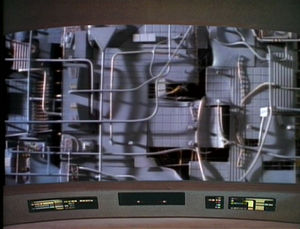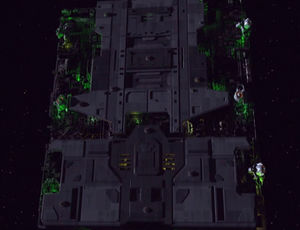Borg adaptation
Adaptations are a variety of mechanisms by which the Borg defend themselves from threats and circumvent enemy defenses.
Defensive Adaptation
Shields
Adaptation is generally referred to in the context of shields. Both drones and cubes can protect themselves from energy weapons with shields. The Borg adapt their shields to provide defense against phasers and other energy weapons. Specifically, the Borg identify the operating frequency of the beams used against them and screen against that frequency. Drones can prevent any damage from a hand-phaser, and cubes can repel the full power of a Galaxy-class starship. This makes the Borg highly resistant to the weapons of most powers in the Milky Way.
Shield adaptation will not negate an unlimited amount of firepower. With a sufficient number of attacking ships, Borg cubes can still be damaged despite their defensive adaptations.[1] Borg defenses often have little effect on weapons they have not previously encountered during initial attacks, but they typically develop defensive adaptations within a few attacks.
Frequencies
The most common examples of adaptation in Star Trek involve directed-energy weapons with specific operating frequencies. Frequency-based weapons such as phasers become ineffective after the Borg have adapted. In combat, Federation starships rapidly change the frequency of their weapons to hinder adaptation. However, rapidly rotating frequencies is, at best, a delaying tactic. Federation hand phasers can also be programmed to rapidly change frequencies, allowing a security officer to disable or kill several drones before the Borg adapt and render his weapon useless.
Non-Canon
In Star Trek Online (early 25th century) a device is easily available to randomize frequencies in personal weapons within a few seconds, thus maintaining efficiency indefinitely (the effect is automatic in certain elite weapons). Presumably, starships can use the same mechanism automatically, since no adaptation is present in STO space combat.
Repair
Adaptation also appears as a formidable self-repair mechanism[2]. After taking significant damage from phaser fire, the Borg Cube repairs itself in minutes. The cube's outer hull is constructed of ductile material conducive to self-repair. It is unclear whether all Borg cubes possess this ability. Other Borg cubes have not shown this ability for rapid repair.
Adaptation versus Projectile Weapons
In Star Trek: First Contact, Captain Picard fires a holographic Thompson submachine gun at two Borg drones. The drones do not adapt and are killed; and in numerous instances, borg drones are struck in close quarters by fists, phaser rifles, and bladed weaponry. The Borg possibly "adapt" to projectile-weapon species with armored tactical drones and tactical cubes[3]. However, no evidence indicates Borg drone shields are effective against kinetic penetrators.
Adaptive Offense
Borg cubes can also adapt to the defensive shields of enemy vessels. While their tractor beams may not initially lock onto a shielded target, they are somehow able to quickly determine the operating frequency of the opposing shield, allowing them to bypass it and achieve a tractor beam lock. In addition to holding the target relatively still in space, the tractor beam rapidly drains energy from the shield, quickly making it completely ineffective.
The Federation developed a countermeasure called "shield nutation" to defend against Borg tractor beams. The operating frequency (and possibly other variable characterstics) of the shield changes rapidly and randomly to prevent the Borg tractor beam from achieving a lock. Unfortunately, this countermeasure was not effective for long; the Borg were able to bypass the modified shield and lock on in less than 20 seconds.



